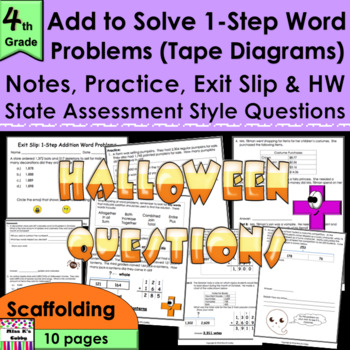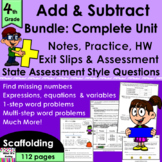Add 1-Step Halloween Word Problems no prep: notes, CCLS practice, exit slip, HW
- PDF
Also included in
- This bundle includes 9 math lessons, a review lesson & assessment. It is designed to replace or supplement any math curriculum program. My lessons and assessments are aligned to the common core standards and state assessments. Notes, strategies, tips, and questions are research based and rigoroPrice $18.54Original Price $20.60Save $2.06
Description
This math lesson is designed to replace or supplement any math curriculum program. My lessons are aligned to the common core standards and state assessments. Notes, tips, and questions are research based and rigorous.
Goal: Students will add up to 4-digits to solve 1-step Halloween themed word problems. They will use tape diagrams to model their work. They will write an explanation of their thinking. (10 pages for students + answer key)
This complete no prep, printable math lesson includes:
- goal statement (“I can” statement)
- notes that are simple, bold and easy to understand with visual aids
- 2 different example problems
- a gradual progression of more difficult problems (challenges included)
- multiple-choice questions & open-response questions in CCLS assessment format
- clear, bold font and pictures
- plenty of workspace
- homework
- 3 spiral review problems
- exit slip for progress monitoring & immediate feedback (can also be used as morning work, bell ringers or ongoing spiral review)
- answer key for quick, easy grading
My lessons are designed to help students at all levels succeed. My district has been using these lessons for a few years and students LOVE math and are truly engaged in learning. Lessons are designed to help differentiate instructions for all learners, from those who have special-ed needs or are struggling learners to gifted students. Each lesson begins with clear step-by-step notes and helpful strategies. Scaffolding, tips and reminders are included throughout the lesson. Parents and substitute teachers comment how much they love the “helpers” and the easy-to-follow, predictable format.
Each lesson builds complexity by starting with easy problems and progressing towards challenging problems to help students become confident. This encourages a growth mindset as students feel that they can succeed with problems labeled as a “challenge”. The different levels of questions allow for learning to be personalized as students can go deeper at their own pace. Students using my lessons are motivated to work through to the hardest problems to show true mastery of the concept.
Brain based learning theory shows that in order to retain new information it must be applied to new situations in order to solve problems. My lessons progress with constant shifting of question wording and formats so that students begin to truly apply the new concept. Each question is purposeful and meaningful to students' math comprehension and mastery of concepts.
Clipart, clear font, and plenty of workspace make this product user-friendly. Quality homework spirals a sample of questions completed during school. Exit slips provide immediate, constructive feedback and help teachers track and progress with data driven instruction.
Please adhere to my TERMS OF USE included in this document.
TERMS OF USE - © Miss K’s Cubby
This item is a paid digital download from my TpT store:
https://www.teacherspayteachers.com/Store/Miss-Ks-Cubby
As such, it is for use in one classroom only. This item is also bound by copyright laws. Redistributing, editing, selling, or posting this item (or any part thereof including clipart) on the Internet are all strictly prohibited without first gaining permission from the author. Violations are subject to the penalties of the Digital Millennium Copyright Act. Please contact me if you wish to be granted special permissions!
Thank you for your purchase!






